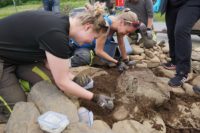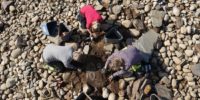 A Roman bronze cauldron has been discovered in a burial cairn in Gylland, central Norway. After removing the top layer of stones from the cairn site, archaeologists found a layer of slabs in the center. When they lifted one of those stones, they found the cauldron. It has been placed on a small flat stone. Around it and inside it were fragments of burned human bone. Underneath and on top were pieces of birch bark, indicating it had been wrapped in bark before burial.
A Roman bronze cauldron has been discovered in a burial cairn in Gylland, central Norway. After removing the top layer of stones from the cairn site, archaeologists found a layer of slabs in the center. When they lifted one of those stones, they found the cauldron. It has been placed on a small flat stone. Around it and inside it were fragments of burned human bone. Underneath and on top were pieces of birch bark, indicating it had been wrapped in bark before burial.
It was in poor condition, likely crushed by the weight of the hundreds of kilos of stones pressing down upon it for centuries. To excavate the fragile object and its soil fill in controlled conditions, the cauldron was snugly wrapped and transported whole to the Norwegian University of Science and Technology’s conservation laboratory.
 The burial dates to around 150-300 A.D. It is of a type known as Østlandskjele, meaning “eastern boiler” because they have been found mostly in Roman Iron Age graves in eastern Norway. They were mass-produced in Italy or in Roman Germania and arrived in Norway via trade networks or in gift exchanges. As imports, they were valuable prestige items reserved for the elite of Scandinavian society and often used as a cinerary urns, an indicator of how highly prized they were.
The burial dates to around 150-300 A.D. It is of a type known as Østlandskjele, meaning “eastern boiler” because they have been found mostly in Roman Iron Age graves in eastern Norway. They were mass-produced in Italy or in Roman Germania and arrived in Norway via trade networks or in gift exchanges. As imports, they were valuable prestige items reserved for the elite of Scandinavian society and often used as a cinerary urns, an indicator of how highly prized they were.
The discovery in Gylland testifies to the power and prosperity in this region in Roman times.
“This wealth was probably linked to the passage of traffic and Gylland’s proximity to important land resources like bog iron, which was the basis for the extensive iron production in Trøndelag in Roman times,” says Moe Henriksen.
 Mass-produced though they were and as many of them have been found, particularly in the east, these cauldrons are still very rare survivals. Only about 50 of them have been discovered in the entire country, and the last one to be found in central Norway was discovered in the 1960s. That one contained gold finger rings, a sword, arrowheads and bear claws as well as cremains.“This wealth was probably linked to the passage of traffic and Gylland’s proximity to important land resources like bog iron, which was the basis for the extensive iron production in Trøndelag in Roman times,” says Moe Henriksen.
Mass-produced though they were and as many of them have been found, particularly in the east, these cauldrons are still very rare survivals. Only about 50 of them have been discovered in the entire country, and the last one to be found in central Norway was discovered in the 1960s. That one contained gold finger rings, a sword, arrowheads and bear claws as well as cremains.“This wealth was probably linked to the passage of traffic and Gylland’s proximity to important land resources like bog iron, which was the basis for the extensive iron production in Trøndelag in Roman times,” says Moe Henriksen.
The latest find has been x-rayed and contains no metal objects. It could still contain organic remains, however, in addition to the burned bones of the deceased. The soil inside the cauldron will be excavated thoroughly with a brush and sieved to detect even the smallest fragments.
Here is video of the slab being lifted revealing the cauldron for the first time. (Unrelated sidenote spurred by a challenging experience repaving a garden path, that slab looks like slate to me. I’m impressed that it made it through the millennia without chipping to bits given the weight of stone on top of it.)